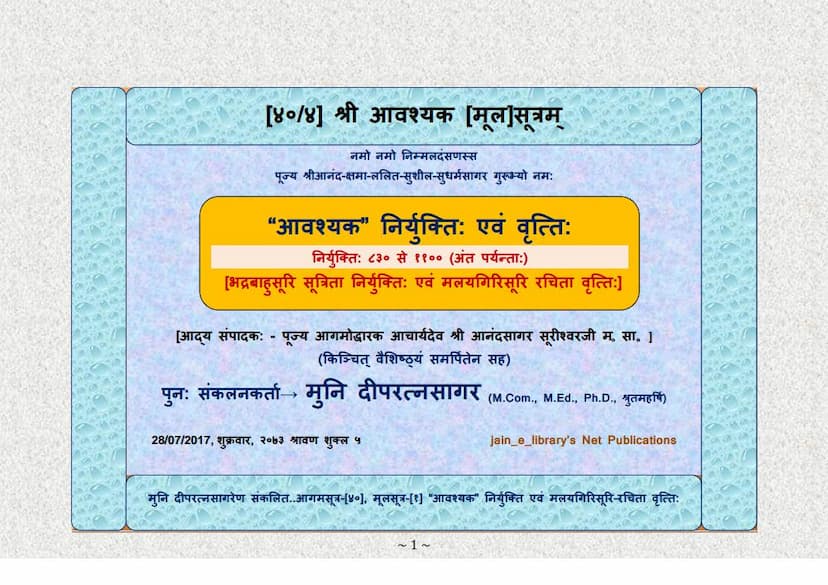Aagam 40 Aavashyak Malaygiri Vrutti Mool Sootra 1 Part 04
Added to library: September 1, 2025

Summary
The provided text is the fourth part of the fourth volume of the Jain text "Aagam 40 Aavashyak Malaygiri Vrutti Mool Sootra 1". It is a compilation by Muni Deepratnasagar, based on the original work edited and compiled by Pujya Aagmoddharak Acharya Shri Anandasagar Surishwarji. The primary content is the commentary (Vrutti) by Shri Malaygiri Suri on the "Aavashyak Niryukti" of Shri Bhadrabahuswami, which itself is an explanation of the "Aavashyak Mool Sootra".
Key aspects and content of the provided text (Part 04):
-
Title and Authorship: The book is identified as "Aagam 40 Aavashyak Malaygiri Vrutti Mool Sootra 1 Part 04". The author of the Vrutti is Shri Malaygiri Suri, and the compiler/re-compiler is Muni Deepratnasagar. The original editing and compilation were done by Pujya Aagmoddharak Acharya Shri Anandasagar Surishwarji.
-
Nature of the Text: It is a detailed commentary on the Jain scripture "Aavashyak Sutra," specifically focusing on the "Niryukti" part and its elaborate explanation by Malaygiri Suri. The Niryukti itself is attributed to Bhadrabahuswami. The text covers a significant portion of the Niryukti, from verse 830 onwards.
-
Content Summary (based on the page-wise index/subjects): The provided pages primarily contain an extensive index or table of contents for the commentary, outlining the various topics discussed. These topics delve into intricate philosophical and practical aspects of Jainism, particularly related to the "Aavashyak" (obligatory duties). Some of the key themes covered in this part include:
- Classification and discussion of various concepts: The text meticulously breaks down and explains concepts like knowledge (Jnana), sensory perception (Indriyavishaya), spiritual stages (Gati), karmic principles (Karma), time (Kala), space (Kshetra), substance (Dravya), and modes (Bhava).
- Discussions on different types of knowledge: It elaborates on various types of knowledge, including sensory knowledge (Avadhi), mental knowledge (Manahparyay), and omniscience (Kevaljnana), discussing their scope, limitations, and characteristics.
- Nirvachana (Etymology and Meaning): A significant portion is dedicated to explaining the meaning and origin of key terms and concepts through detailed etymological analysis, often linking them to narrative examples or philosophical reasoning.
- Detailed analysis of concepts like Samayika: The text provides a deep dive into the nature, conditions, and attainment of Samayika (a state of equanimity and meditation), including its various aspects and classifications.
- Illustrative Examples and Narratives: To explain complex philosophical points, the commentary often draws upon illustrative stories and examples from Jain tradition, featuring ascetics, kings, and divine beings.
- Philosophical Debates and Nuances: It touches upon different philosophical viewpoints within Jainism, addressing potential contradictions and offering interpretations to resolve them.
- Detailed breakdown of the "Namah" mantra: The text extensively analyzes the five revered entities of the Namahkar mantra (Arhat, Siddha, Acharya, Upadhyaya, Sadhu), discussing their attributes, meanings, and the reasons for their veneration.
- Analysis of 'Karan' (Action/Creation) and 'Bhava' (State of Being): It delves into the philosophical underpinnings of actions and states of being, categorizing them and explaining their significance.
- The concept of 'Naya' (Viewpoints): The commentary discusses various epistemological viewpoints (Naya) within Jain philosophy and how they relate to understanding the Aavashyak Sutra.
- The Nature of the Soul and Liberation: The text touches upon the nature of the soul and the path to liberation (Moksha).
- Detailed explanation of the concept of 'Upasarga' and 'Parishaha': It discusses afflictions and austerities, explaining how spiritual practitioners endure them with equanimity.
- The concept of 'Loka' (Universe) and its divisions: The text elaborates on the Jain cosmological understanding of the universe.
- The purpose and benefits of Aavashyak duties: Throughout the commentary, the underlying purpose and spiritual benefits of performing the Aavashyak duties are highlighted.
-
Compilation and Editing: Muni Deepratnasagar's effort in re-compiling and presenting this work is emphasized, along with the original contribution of Acharya Anandasagar Surishwarji. The aim is to make these profound teachings accessible, especially through digital platforms like "jain_e_library.org".
In essence, this part of the "Aagam 40" series is a scholarly and detailed exposition of a foundational Jain scripture, aiming to provide a deep understanding of its philosophical, ethical, and practical dimensions through the commentary of Malaygiri Suri.